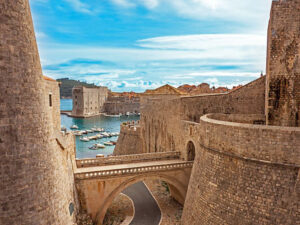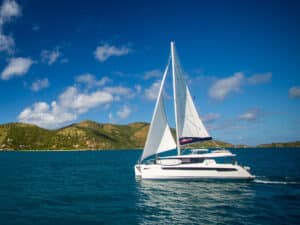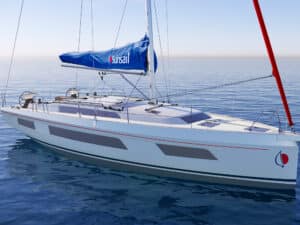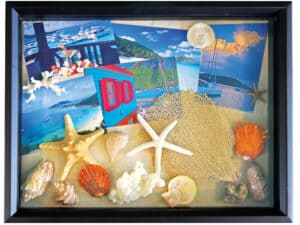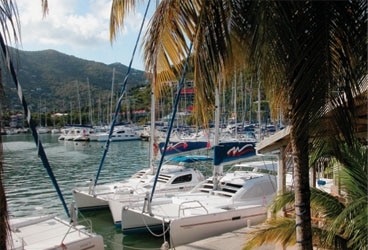
FeatPillsburyCatMono368
“There’s the moon!” came the cry from the cockpit. I put aside the Caribbean spices I was rubbing on our dinner and climbed up the companionway steps to have a look. Sure enough, the faint outline of the totally eclipsed full moon had just popped over the darkened hillside at Cane Garden Bay, on Tortola in the British Virgin Islands. Wisps of reggae music drifted out from a bar on shore, and on the stern rail, coals in the barbecue glowed red, just about ready for cooking. Then it hit me: What had started as a fairly straightforward story assignment was quickly turning into Mission: Impossible. In desperation, I turned to my rum drink.
It had sounded oh-so-simple last fall back at the office in Newport, Rhode Island: Gather a crew, head to The Moorings base on Tortola in late February, spend a few days testing and reviewing a new Moorings 4600 catamaran, shift our bags onto a new Moorings 51.5 monohull, then decide once and for all which is more fun, a big, stylish cat or a long and beamy monohull.
Now, six days into it, with just a day and a half left, none of us could say which boat we liked better. For most of the crew, this had been their first time sailing a catamaran, and Cascadura, fresh off the drawing boards of designers Melvin & Morrelli and built by Robertson and Caine, made quite the first impression. With the square footage of a condo, four roomy cabins, a sprawling saloon, and spacious cockpit, the cat sure was quick across the water.
Still, aboard the monohull Steer It Up, pounding into the trades earlier that afternoon on our way from Jost Van Dyke and along the north shore of Tortola, we went way past our evening’s destination simply because it was just so darned much fun to be heeled over, with warm spray occasionally washing over the crew sitting on the high-side bow.
Lilly, my 15-year-old daughter, was at the helm and taking great delight in seeing her sister, Rebecca, on leave from college, and her mother, Sue, get drenched by a wave. “Dad, you can’t do this on a catamaran,” she said, tipping her hand as to her sailing preferences-at least at that moment.
Peggy, my brother David’s wife, was hinting at her preferences, too, as she chomped down a Bonine and tried to stare off at the horizon. For the first four days aboard Cascadura, she hadn’t felt even a twinge of seasickness, thanks to the catamaran’s lack of heel. Still, once Steer It Up was hanging off a mooring and we were ready to go on the second snorkeling safari of the day, Peggy and a couple of other queasy crewmates were ready to give the boat a second chance. The broad swim platform made it easy to climb into the RIB, and a storage locker in the stern meant masks and fins were right there, ready to go. It had been a bit more difficult to hold the inflatable alongside one of the stern platforms of the catamaran, and the storage for the swim gear was under a seat in the cockpit.
Preparing for the Test
Rounding up a volunteer crew for this arduous expedition proved to be fairly easy. Since there was no way I’d be allowed back in the door if I headed for the B.V.I. and left the family home to shovel snow, that took care of two cabins. Dave, Peggy, and their teenage son, Liam, had been frequent sailing companions over the years, and I knew if I explained the nature of the task, they’d be willing to trade parkas and long johns for T-shirts and swimsuits. And with one berth left to fill, I made it a full-on family affair and convinced my cousin, Joe Donovan, that his seasoned opinion would be highly valued as we tested two new models plus various pieces of gear and sailing angles. A Boston land baron of sorts, Joe’s in his spry 70s and grew up around boats. He’s well suited for the Caribbean pace of life, holds his own on the dance floor, and enjoys just about any cuisine, as long as it’s local. So that was the team: three generations, six cousins, and two wives, all ready to take on whatever the islands and the boats would dish out.
Because of school and work schedules, my family would join us a couple of days late. So, the night before our charter was to begin, I met David, Peggy, Liam, and Joe at The Moorings’ Mariner Inn, at the company’s base in Road Town, Tortola. Before we headed off to a nearby restaurant to go over our detailed boat-assessment matrix and discuss what inspection duties each crewmember would have, I took the team down to the dock to see the 4600. Standing by the stern, I believe Joe mentioned something about it being bigger than some of the apartments he rents out.
Sold privately as the Leopard 46 and into charter as the Moorings 4600, this new catamaran from South Africa was a 2007 CW Boat of the Year nominee. It’s an impressive boat to look at, with thin hulls below the waterline (for performance) that flare out markedly above the waves (for living space). The sleek-looking house sports louvers along the forward windows to provide shade from the tropical sun, comfortable seats for lounging crew, and easy-to-navigate steps to the cabin top. Lit up for the evening, the saloon looked inviting from dockside, with rich wood tones set off by white laminates and dark Corian countertops. An outdoor dining table and U-shaped benches took up one side of the cockpit, while to starboard, half a level higher, a helm station and bench sat perched beneath a hardtop bimini. Though we had serious work to do in the coming days, this boat hinted at fun.
And it was. The next day, we stowed our gear and provisions and got under way shortly after noon. With Joe and Dave manning the dock lines and Liam tending to the inflatable, I eased the throttles into forward and we moved slowly ahead. Forgoing the wheel for the moment, I shifted the starboard engine into reverse once we’d cleared the slip. Cascadura spun easily to the right as I shifted back into forward, and as we gained way, I let the wheel and rudders take over. We were on our way.
Learning Cat Tricks
As we motored slowly out of Road Harbour and into the breeze, Dave and Liam headed for the mast to get sail up. The previous charter guests must have had a lot more breeze, and it took a few minutes to sort out the two reefs they’d tucked in, but let’s just say it was also an opportunity to see firsthand how easy it is for the helmsman to communicate with someone at the mast. Once the aft reef lines were released from clutches on the boom by the gooseneck, the sail looked much more nautical, and we fell off on a course that would take us to Norman Island via the rock outcropping called The Indians, where we planned to pick up a mooring and do some serious fish watching.
The 4600 was designed to replace The Mooring’s aging fleet of 4700 catamarans. Its four cabins-two in each hull, separated by private heads with showers-each have wide double berths, hanging lockers, and lots of room to stand and dress. In practical terms, how much room is there? Well, after three days aboard, Liam discovered a fifth cabin, forward in the starboard hull, for a captain or crew on a crewed charter.
From the cockpit, a sliding glass door gives way to the saloon, which features a nav station forward to starboard and a large dining table amidships. The galley takes up the aft, starboard corner and is laid out for easy cooking both under way and at anchor. With all the under-counter space that’s available, it seemed a little odd to locate the side-by-side fridge and freezer on the other side of the saloon, but we quickly got used to moving ingredients to the countertop, and it did mean thirsty crew could get to cold beverages faster and without disturbing the chef.
Liam had the helm much of the way to The Indians, but then headed to the bow to help his father with mooring duty. I’d like to say we dropped sail, motored smoothly to the ball, rigged a bridle, and effortlessly cleated it off.
But that wouldn’t be completely accurate. Though the visibility from the helm was excellent under way-you could see three corners of the boat while seated and the fourth by turning around-in close quarters, it was tough for me to judge just where the ball was in the 24 feet and 10 inches of beam between the hulls. And then there was the windage, brought on by a combination of freeboard and cabin house, that was out to get us. About the time I got the knack of using the twin screws to hold us in place while Dave threaded the eye of the mooring pendant with our dock line, we remembered the dinghy, whose painter was about to get sucked into the starboard-side prop. By our third try, our roles for the week were pretty well set: I’d steer, Joe would fend off the RIB, and Peggy and Liam would stand by, intrigued, as Dave found increasingly diverse ways to secure our lines.
With the clock ticking away on our first afternoon, we wasted no time in taking to the water. Swimming in from the boat, the bottom rose up and into focus, and soon Liam was getting his first taste of just how delicious clear, blue water, coral, and brightly colored fish can seem after a long, cold February up north. Later that night, after we were welcomed aboard the William Thornton floating restaurant, Liam (with the permission-I think-of his parents) got his first taste of another Caribbean delicacy: a rum drink.
We left The Bight in the morning under power, and once seemingly well out into Flanagan Passage, we turned into the wind to run up the main. Unlike the previous afternoon when we had no land in front of us, this time we motored slowly toward Water Point on Norman as Dave cranked on the halyard winch. Cascadura has a mast that stands 70 feet 9 inches, and we quickly learned that it takes quite a bit of time-and sea room-to get the two-part halyard all the way up.
With the main raised and the rocks pretty darn close, we fell off and eased out the jib. I say “eased,” but really it came out fast, and when I went to sheet it home to stop its fluttering, the portside winch’s self-tailing mechanism came off in my hand. Now this was a bit of a pickle. The Mooring 4600 is set up with a double-ended mainsheet, and both ends run through rope clutches. This is good, since having two winches on the cabin top means one can always be loaded up with one end of the mainsheet while the other is used for the jib sheet. As CW Boat of the Year judges noted last fall, this means you can spill the main quickly if need be. Right now, though, it wasn’t good, since the wind was up a bit and I was about to use both clutches on the mainsheet while we used the good winch to bring in the jib.
Some in the crew suggested that this might be a good time to place a service call to the charter base, but a few minutes tinkering with the pieces had the winch back together. We concluded that the whole incident served as a good reminder that while we were on a new boat that sees regular inspection and maintenance, it’s still a boat, and the unexpected should still be expected.
That day we sailed the length of Sir Francis Drake Channel, heading for Virgin Gorda’s North Sound and the Bitter End Yacht Club. Man, did we have fun. With the wind far enough ahead that we needed three tacks to clear Tortola and a couple more to favor the shore past Spanish Town, Cascadura danced along at 8.5 knots and sometimes a little more in about 14 knots of wind. Our top speed for the day was 9.4 knots in a gust that hit about 18.
That night, with Saba Rock off our bow, we relaxed, replenished fluids, and had dinner in the cockpit before being lured ashore to the Bitter End by the promise of reggae under the palms. As the trees swayed in the steady trade winds, Joe charmed a waitress and was doing a little swaying of his own on the dance floor.
Day Three had us sailing past George Dog, Great Dog, and West Dog. There was mention of dropping Liam at Cockroach Island, but seriously, it was all mostly said in jest.
Knowing we’d need to be in Trellis Bay on Beef Island the next night to meet my family at the airport, and finding the anchorage at Marina Cay pretty full, we decided that North Sound had been so beautiful that it was worth returning there, this time to Leverick Bay. With the wind on our nose, we chose to motor, which was a good chance to recharge batteries and get a feel for the cat under power. Below, sound levels in the aft cabins were tolerable, and once set, the autopilot took over and made the traveling easy. We lounged on the trampoline and watched the shore fly by at a little better than 8 knots. That night, we had the best conch fritters of our trip at the restaurant at Leverick Bay Resort & Marina.
Early the next morning, we ran downwind past the northern tip of Great Camanoe and got the feel for driving by instruments to keep the wind off the quarter. A skylight in the bimini over the helm seat provided a good view of the mainsail when sheeted in, but off the wind, the apparent-wind indicator proved to be much more useful. Rounding Monkey Point on Guana Island, we found the moorings all taken, but not to worry. The 4600’s windlass and anchor are stored in a locker just forward of the mast and cabin. There’s a bridle all rigged up and attached to a snubber that hooks up out of the way when not in use. It’s an easy, one-person job to drop and retrieve the hook. We saw our biggest fish at this spot and then hung around to enjoy a late lunch before heading for Tortola’s Trellis Bay and a rendezvous with the rest of our crew.
Three new passengers were easily absorbed by the 4600 as the girls settled in for what would be our last night on two hulls. By morning, the trades had kicked up a few notches, and before leaving the shelter of the harbor, we tucked a reef in the main for the beat around Tortola’s East End. During our boat orientation at the start of our trip, Rean Bowens, our briefer, had stressed the need to tilt up the outboard on the inflatable when we were under way. Unfortunately, no matter how we tried, it wouldn’t stay up, and in these boisterous conditions, we soon decided it would be better to let it fend for itself.
Besides, we had other concerns. In designing the 4600, Morelli & Melvin had super-sized the boat’s stern davits to account for the fact that charterers would occasionally use them without first emptying the water out of their dinghy. In the space between them, in place of a stern rail, the designers built a comfortable-looking seat that, when in harbor, could be folded down to become a dinghy dock and swim platform. On a similar boat that CW judges sailed last fall as part of the Boat of the Year program, this seat had worked great, and the judges were impressed with the feature. However, on Cascadura, one of the first 4600s to be launched, problems had developed with the davits’ attachment points, and one of them, along with the seat, had been removed for repair. Without it, the stern of the now actively pitching boat was a walkway from which to fall. I was glad to learn, subsequently, from Van Perry, The Moorings brand manager, that the davits have now been re-engineered and that new ones are being retrofitted across the fleet and installed on all new boats. Such is the learning curve with a new model line.
That concern aside, by late morning we were back in Road Town, and in full candor, we weren’t thrilled to be jumping ship just yet.
A Hull Removed
By noon we had the boat cleaned and our gear trucked down the dock to Steer It Up, and we were ready for the second half of our adventure.
This time, Moorings briefer and charter captain David Blacklock walked us through the 51.5, a Cyclades from Beneteau designed to update accommodations and provide a roomier cockpit than the fleet’s older Beneteau 50s.
Like the cat, most of the 51.5’s switches and valves were clearly labeled and fairly intuitive. Controlling the genset and the AC was a bit more complicated on this boat, but I seriously doubted we’d use either. What did strike me, though, is where on each boat someone decided to locate the breaker switch for the windlass. On Steer It Up, it was on the front of the starboard aft berth, and every time I climbed out of the bunk, I managed to trip it; had I not remembered to look, I’d have been sadly disappointed when trying to anchor in an emergency. At least on the 51.5 you could see the breaker. On Cascadura, it was in the top corner of the cabinet under the nav station, reached by lying upside down on the fixed nav-station seat, inching into the cubby with your feet in the air, and then groping for the toggle. (Good entertainment for the rest of the crew, of course.)
Though plenty beamy for a monohull-16 feet amidships-at first blush the cabins and heads felt smaller on Steer It Up, although we certainly found them adequate. And in contrast to the open saloon and cockpit of the Moorings 4600, you definitely felt as though you were “down below” on the 51.5. Later, of course, we liked that the kids were “down below,” while we bigger kids got the cockpit to ourselves.
As we pulled slowly out of our slip, I could feel the difference in maneuverability, too. Those twin props on the cat, 20 feet apart, gave you lots of steering options when gathering way.
Given our morning’s boisterous sail, we went for a reef in the 51.5’s main and a not-quite-full genoa as we took a right leaving Road Harbour, headed for Thatch Island Cut and Jost Van Dyke. This afternoon, Rebecca settled in at the port wheel and did the driving. Unlike the cat, where the person steering often found herself alone, most of us now sat under the bimini in the cockpit, and a couple of others sunned on deck.
Twin helms give you easy access to the 51.5’s roomy cockpit, with its fixed centerline table that has room inside for gear and doubles as a good brace when heeled. Checking our speed over the ground, I was surprised to see we were within a knot of what the cat was making in similar winds that morning. Walking about on deck, even though we heeled a bit, the boat felt steady under foot, while I recalled that it took some getting used to the quicker movements of the cat when it pitched in the chop.
Past Soper’s Hole, on Tortola, we hardened up on the wind and scooted across the channel past Little Harbour to Diamond Cay, at Jost Van Dyke. With its big main and relatively small foretriangle, we found the 51.5 appreciated one reef (at least) if the trades were to be forward of the beam.
In gusts, particularly, the boat seemed to want to round up, and I needed to steer hard to bring things around. In retrospect, we should’ve tied a second reef, perhaps.
At our chart briefing, the “bubbly pool,” located a short walk from a local restaurant, Foxy’s Taboo, had been recommended as a bonus side trip. Perhaps the tide was wrong for our visit, but I found the fish and bird action in the shallows along the shore more inspiring than this swimming hole.
That evening, we put the 51.5’s inline galley to good use preparing dinner. Amidships is an island counter area with a freezer beneath its aft end and a storage area forward. It makes a great platform for spicing fish and would be a good brace if cooking under way. With the hatches open, there was ample ventilation in the main saloon, although while sleeping, Steer it Up’s aft cabins weren’t as airy as those on Cascadura.
Up early the next morning, we headed for Sandy Cay for breakfast and a swim. The boat’s 6-foot-7-inch draft kept us farther from the beach than the visiting catamarans, but with a motorized inflatable, who cared? Dropping and setting the anchor was easy as pie, thanks to the windlass and good cleats for the snubber, although communications between the helm and bow were a bit more vociferous than on the cat.
That night found us creating our own full-moon party in Cane Garden Bay. Dinner was procured at the market ashore, and as we enjoyed the evening, we concluded that as impressive as Cascadura had been, after a couple of days of sailing, Steer It Up was growing on everyone. Joe liked the fact that people tended to sit closer together and talk more, and I must say, I really appreciated the feel of the breeze, which always seemed to be missing in the cockpit of the catamaran. We awoke the next morning, all realizing we had a lot of serious testing to do on this final day on the water if we were going to accomplish our mission. We beat our way east along Tortola’s coast, tacking efficiently past Guana Island and Great Camanoe. For our last night, we went for a mooring in Tortola’s Fat Hogs Bay, where ashore we found the bustling neighborhood a welcome respite from the polished, resorty harbors we’d visited elsewhere in the B.V.I. Dinner at Emile’s Cantina couldn’t have been better, and that night, we sat up late in the cockpit-long after the discussion of first cousins, second cousins, and once- and twice-removeds had ended-still grappling with how to decide which we liked better: one hull or two. The cat had a lot going for it: room to roam, great accommodations, a deck layout that let the sailors sail and the nonsailors relax without heeling. Still, we had a lot of fun crashing through the waves on Steer It Up, and the wind in our faces and occasional spray felt pretty darned good. Both boats took us to beautiful beaches, breathtaking bays, water blue enough to get you through the rest of the winter back home, and showed our kids a truly fine time.
One hull or two? Maybe it’s a question you just can’t answer. But I’d be willing to give it another try.
Mark Pillsbury is CW’s senior editor.

